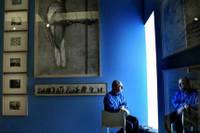SABC poll proved whites have phones
Sometimes we South Africans still have allot to be ashamed about. Kwailawai* likes Steve Hofmeyer but....
Steve Hofmeyr is one of the Greatest South Africans yet the 18th century's own Madiba gets ignored? Please! Writes Max du Preez in the Star.
It was a good idea. It could have helped South Africans so much in their process of trying to identify with a shared past. Instead, the SABC's programme on the hundred greatest South Africans has turned out to be a huge embarrassment for the public broadcaster.
The only thing it proves is that white South Africans have telephones. Not that it's the SABC's fault, really. It was the fault of the silly producers who thought one could do an experiment like that in the South Africa of 2004 by asking the public to vote. It was skewed even before the voting started: most white South Africans do have telephones, cellphones and access to the Internet; most black South Africans don't.
I'm trying to be generous here, but really, Eugene Terre'Blanche, Steve Hofmeyr, Brenda Fassie, Hansie Cronje, DF Malan and Hendrik Verwoerd among this nation's one hundred greatest citizens? In our entire history?
They were newsmakers, not great people. And if we wanted a list of newsmakers, where are Eugene de Kock, Dirk Coetzee, Wouter Basson or Gideon Nieuwoudt? What about Andre Stander, Colin Chauke or some of the serial killers and rapists of the past few years?
These popularity contests can't be taken seriously. On some levels, this kind of popular democracy doesn't really work. If all South Africans were asked today whether most white farmers' land should be taken away and given to landless blacks, my guess is two thirds would say yes.
Yet the list of Great South Africans tells us a lot about our society. Few of those who bothered to vote sat back and thought about South Africans as one nation, trying to figure out who had made a difference, a contribution over the past 400 years.
Rather, people voted to get their "own" in the list. We had better vote in our thousands for "our" leaders, otherwise we will be marginalised, they thought. This seems to be especially true of white Afrikaans-speakers.
On the other hand, if it is true that mostly white people voted, then it must also follow that a lot of them voted for Thabo Mbeki, Desmond Tutu and Winnie Mandela, all among the top ten. It is depressing to see how people mostly voted in racial blocs. We are clearly a very long way away from identifying with the same heroes of our past.
To me, the most surprising omission from the list of 100 was King Moshoeshoe of the Basotho. I spent the past few years researching his life and philosophies for a documentary film for the University of the Free State - to be broadcast on SABC2 at the end of October - and for a popular book on South African history to be published in the same week. I know a bit about the man. I can't imagine anyone more suitable for all South Africans to associate with and vote for.
Any person who really understood Moshoeshoe's role in history would have voted him number two on the list after Nelson Mandela. Moshoeshoe was the Mandela of the 19th century.
It was Moshoeshoe who stabilised South Africa after the tremendous upheavals of the early 1800s, sometimes referred to as the Lifaqane or Mfecane. It was a time of great droughts, of social instability, of conquering chiefs and encroaching colonialism.
Chiefdoms and clans attacked each other from the east coast right up to the highveld, creating a domino effect and incredible human suffering.
Moshoeshoe was the only leader of the time who did not partake in the violence, but took an approach of defending, making peace, rehabilitating and gathering people around him.
Moshoeshoe was a revolutionary diplomat and an extraordinary innovator.
He was never beaten in war, not by the British, the Boers of the Free State, or by the forces of Matuwane, Mzilikazi or Sekonyela.
More than anyone else at the time, he had reason to be arrogant and authoritarian. Yet he remained humble, serving his people with a sense of democracy virtually unknown in the world at the time. He embraced new ideas and technology, yet cherished his people's culture and customs.
In every way he was a man the whole of Africa could look up to - even today. He was a one-man African Renaissance.
But the citizens who voted for the SABC's programme regarded Steve Hofmeyr and Eugene Terre'Blanche as greater contributors to our nation than King Moshoeshoe.
There are other great men and women who should have been among the top 20 who never made it on to the list at all. The great Boer War general and guerrilla leader Christiaan de Wet, for instance. The Khoikhoi leader Autshomao. The extraordinary sage and philosopher Mohlomi. The world-renowned palaeo-anthropologist Philip Tobias. The writer JM Coetzee. Activists Bram Fischer and Helen Joseph.
We missed a great opportunity here. This initiative could have meant so much to us as a nation. We will simply have to explore other ways of finding common historical figures we can all identify with.




